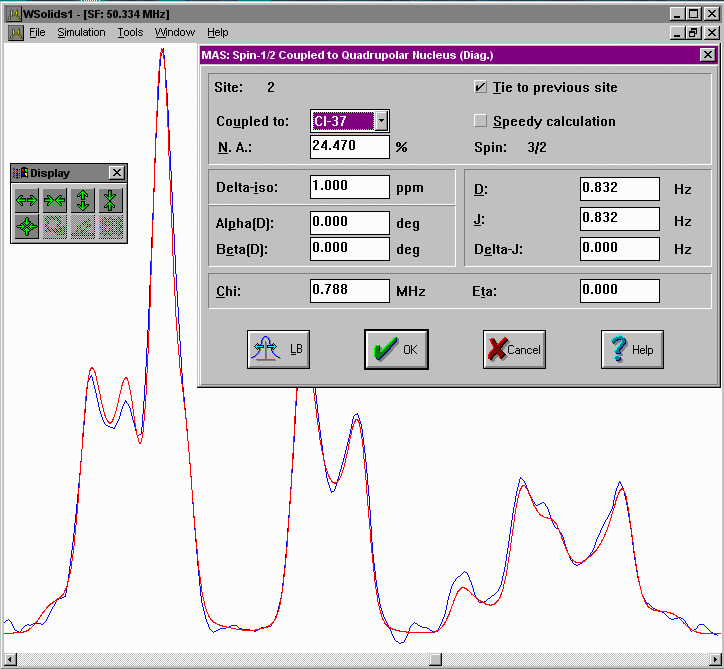
|
WSOLIDS1:
MAS, Spin-1/2 -- Spin-S (Diag.)
|
Description
This squeezed picture shows an example for the succesful simulation of a MAS spectrum
of a spin-1/2 nucleus that is coupled to a quadrupolar nucleus in a powder sample.
It is the 13C MAS NMR spectrum of a chloroketosulfone, where carbon is coupled
to Cl-35 and Cl-37, and the results have been published in:
K. Eichele, R. E. Wasylishen, J. S. Grossert, A. C. Olivieri:
The Influence of Chlorine-Carbon Dipolar and Indirect Spin-Spin Interactions on
High-Resolution Carbon-13 NMR Spectra of Chloroketosulfones in the Solid State.
J. Phys. Chem. 1995, 99, 10110-10113.
Click on the picture to have a better look.

Background
The quadrupolar interaction at a quadrupolar nucleus causes its axis of quantization
to be tilted away from the direction of the external magnetic field. This also modifies
the spatial dependence of the dipolar interaction, so that magic-angle spinning is
not able to suppress the heteronuclear dipolar coupling in the spectrum of the
spin-1/2 nucleus, resulting in splittings and broadenings. Similar effects can be
transmitted through the indirect spin-spin coupling. If the nuclear quadrupolar
coupling constant is on the same order of magnitude as the Larmor frequency of the
quadrupolar nucleus, the combined Zeeman-quadrupolar Hamiltonian must be diagonalized
at each orientation and averaged over a rotor period to calculate a theoretical spectrum.
This picture also illustrates the workings of the Tie to previous site feature:
the parameters of the C-13,Cl-37 isotopomer are tied to those of the C-13,Cl-35 isotopomer
by using the ratios of the magnetogyric ratios and nuclear quadrupole moments as factors.
Examples
The SVG images shown below were produced using the
following tools: my own SpecPlot
to plot the spectra, Platon
to plot the molecular structures from X-ray data, and
Inkscape to compose the picture.

|
C-13 CP/MAS NMR spectrum of a powder sample of Ph-C(=O)-CClEt-SO2Ph:
this example of a carbon directly coupled to chlorine uses the simulation of two
isotopologues, Cl-35 and Cl-37, at three applied magnetic fields.
It is the example shown in the description above.
The experimental spectra focus on the "region of interest", achieved by exporting the appropriate region in TopSpin to an ASCII file. Because WSolids1 scales the display
according to the highest point, the 2.35 T spectrum has a problem with the overlapping aromatic carbons. Therefore, this region has been truncated to a value slightly lower
than the highest peak of interest (using an advanced text editor, Notepad++, in column editing mode).
|
Another hint: the experimental spectra are referenced wrt TMS. However, to demonstrate the field dependence of the multiplet, a scale in Hz with 0 Hz at
the isotropic shift position would be more interesting (such as shown in the left figure). Using WSolids1, you could generate the spectra in the following way: (1) in the
first spin system, set δiso to
zero; (2) under "Tools|Reference Spectrum" select the experimental spectrum and set the value to add to the negative of the isotropic shift, -95.2; the experimental spectrum will
apparently disappear; (3) under "Simulation|Default Parameters" set the check mark for "upon closing dialog, get parameters from experimental spectrum"; after OK, the calculated
spectrum will disappear also (actually, in reality); (4) reset the display: Ctrl-R or "Window|Reset Display; the experimental spectrum should re-appear (now would be a good time
to export this spectrum); (5) perform a calculation to generate the calculated spectrum (and save to disk, if required).
- You can download a zip file of the WSolids1 document: (ZIP)
- or have a look at the report generated from the WSolids1 document: (XML)
|

|
C-13 CP/MAS NMR spectrum of a powder sample of Ph-C(=O)-CClEt-SO2Ph:
shown above is the example of a carbon directly coupled to chlorine; in this molecule
even the carbonyl carbon which is not directly bonded to the chlorine shows interactions
with the Cl-35 and Cl-37 at lower applied magnetic fields.
The experimental spectra focus on the "region of interest", achieved by exporting the appropriate region in TopSpin to an ASCII file.
- You can download a zip file of the WSolids1 document: (ZIP)
- or have a look at the report generated from the WSolids1 document: (XML)
|



